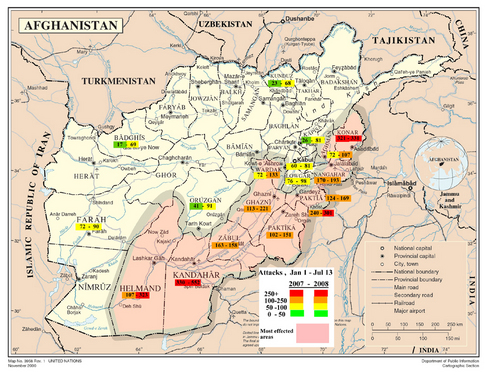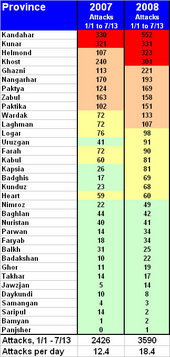Map of violence in Afstan
With 2007 vs. 2008 attack comparison by province, from The Long War Journal (via milnewstbay):
More:
Afghanistan has seen its worst bout of violence since the US overthrew the Taliban government in 2002. Taliban-related attacks and incidents have skyrocketed as the Taliban seeks to destabilize and de-legitimize the weak Afghan government and break NATO's will to fight a protracted counterinsurgency campaign.Lots of hard slog ahead; let's hope the Afghan National Army keeps improving--and the US can send more troops, sooner rather than later. Their Marines though have had their tours extended a month--and more Czechs may be coming.
The number of Taliban-related incidents per day has jumped by almost 50 percent, according to data compiled by Vigilant Strategic Services Afghanistan. The data compares the Taliban-related incidents from the Jan. 1 to July 13 time periods in 2007 versus 2008.
Afghanistan experienced 18.4 attacks per day in 2008 compared to 12.4 in 2007. Much of the violence can be traced back to Pakistan's lawless border region, where the Taliban openly control wide swaths of territory.
More than two-thirds of the Taliban-related violence has occurred in nine of Afghanistan's 34 provinces. Each of the nine provinces borders Pakistan and seven of them border the volatile tribal areas where the Taliban and al Qaeda have a de facto sanctuary and maintain more than 100 camps.
While NATO and Afghan forces have killed an estimated 7,000 Taliban fighters this year, the Taliban have demonstrated the capacity to recruit new fighters. These recruits are often trained in the Pakistani camps before being sent across the border to strike at NATO and Afghan forces.
In the southern provinces of Helmand and Kandahar, the violence has more than doubled. Kandahar and Helmand are two of the three most violent provinces in Afghanistan (first and third, respectively). In neighboring Uruzgan, violence has more than doubled.
Taliban-related incidents have more than tripled in Helmand province (323), although much of the violence in Helmand may be attributed to a US Marine Corps offensive that began this year. The US Marines stated they killed more than 400 Taliban fighters in the southern province since arriving this spring.
Attacks in Kandahar have nearly doubled (553) since last year. Two recent attacks highlight the deteriorating security situation in the province.
The Taliban conducted two successful high-profile attacks in Kandahar in July. Taliban forces overran the Arghandab district and held it for several days after conducting a bold jailbreak in the heart of Kandahar city. More than 1,100 prisoners, including 400 mid- and low-level Taliban operatives, were freed. Few of those freed have been rearrested or killed.
The Taliban are said to control six of Kandahar's 16 districts, according to a US assessment. The Canadian Army and the Afghan government are focusing their efforts on the most populous districts, and control four, including Kandahar city, Arghandab, Spin Boldak and Daman. The Taliban control remote, rural districts where Canadian and Afghan forces have pulled back. The remaining six districts are classified as contested or locally controlled.
The eastern provinces bordering Pakistan's tribal areas account for seven of the remaining top nine most violent provinces. Kunar remains the second most dangerous province (331 incidents) but attacks have remained steady. Attacks increased by more than 20 percent in Khost (301) and doubled in Ghazni (221). Attacks have increased by between 20 and 50 percent in Nangarhar, Paktia, Paktika, Wardak, Laghman, and Logar.
With more resources and a safe haven in northwestern Pakistan, the Taliban, al Qaeda, and allied terror groups have launched numerous attacks on US and Afghan outposts in the eastern provinces. The Taliban are attempting to destabilize the eastern region and overrun Afghan government centers and Coalition bases. The vast majority of these battles end badly for the Taliban. Scores of Taliban their fighters are often killed and no or few US and Afghan casualties are taken.
Outside of the South and East, there has been a rise in attacks in regions that were relatively quiet one year ago. Attacks tripled in Kapisa, Badghis, and Kunduz, and are up in the southwestern provinces of Nimroz and Farah.













0 Comments:
Post a Comment
<< Home